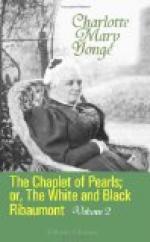How far this has been done, critics better read than myself must decide. I have endeavoured to speak fairly, to the best of my ability, of such classes of persons as fell in with the course of the narrative, according to such lights as the memoirs of the time afford. The Convent is scarcely a class portrait, but the condition of it seems to be justified by hints in the Port Royal memoirs, respecting Maubuisson and others which Mere Angelique reformed. The intolerance of the ladies at Montauban is described in Madame Duplessis-Mornay’s life; and if Berenger’s education and opinions are looked on as not sufficiently alien from Roman Catholicism, a reference to Froude’s ‘History of Queen Elizabeth’ will show both that the customs of the country clergy, and likewise that a broad distinction was made by the better informed among the French between Calvinism and Protestantism or Lutheranism, in which they included Anglicanism. The minister Gardon I do not consider as representing his class. He is a possibility modified to serve the purposes of the story.
Into historical matters, however, I have only entered so far as my story became involved with them. And here I have to apologize for a few blunders, detected too late for alteration even in the volumes. Sir Francis Walsingham was a young rising statesman in 1572, instead of the elderly sage he is represented; his daughter Frances was a mere infant, and Sir Philip Sidney was not knighted till much later. For the rest, I have tried to show the scenes that shaped themselves before me as carefully as I could; though of course they must not be a presentiment of the times themselves, but of my notion of them.
C. M. Yonge
November 14th, 1868
THE CHAPLET OF PEARLS
or
THE WHITE AND BLACK RIBAUMONT
CHAPTER I. THE BRIDAL OF THE WHITE AND BLACK
Small was the ring, and
small in truth the finger:
What then? the faith was large that dropped
it down.
Aubrey De Vere, infant
bridal
Setting aside the consideration of the risk, the baby-weddings of the Middle Ages must have been very pretty sights.
So the Court of France thought the bridal of Henri Beranger Eustache de Ribaumont and of Marie Eustacie Rosalie de Rebaumont du Nid-de-Merle, when, amid the festivals that accompanied the signature of the treaty of Cateau-Cabresis, good-natured King Henri II. presided merrily at the union of the little pair, whose unite ages did not reach ten years.




